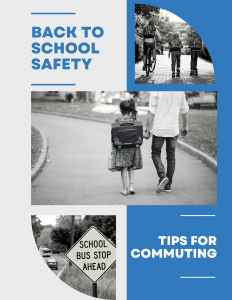Back to School Traffic Safety Tips
By Shannon Butler
Last week, as I was sitting at my work from home office desk, I heard a sound I haven’t heard in some time….about 3 months to be exact. The sound of children playing outside while waiting for their school bus. It brought back some fond memories of childhood friends, waiting for the bus in the dark on winter mornings, snowball fights, heavy backpacks, and the occasional sprint to my stop hoping I hadn’t missed the bus.
Looking back to my years as a student, I realized I had the experience of walking, biking, riding the school bus, activity bus, car pool and mass transit to and from school. Each mode had a set of best practices for arriving safely. Now that students are back in schools, here’s a handy list to review to make sure we all arrive home safely.
For Pedestrians:
- Stay alert don’t walk distracted. Cars, aren’t the only hazard, uneven pavement, curbs, potholes, icy sidewalks or streets, bicycles, scooters and skateboards can also be a source of injury.
- Watch for cars. When crossing the street – even at a crosswalk do not assume a vehicle can see you, or will be able to stop in time in icy conditions or if there is a parked vehicle or snow mound near the intersection. Pedestrians should look left, right, left again before crossing the street and make eye contact with drivers to ensure they see you.
- Obey traffic laws
- Cross with traffic lights or crossing guards where possible
- Walk on the sidewalk if one available. If there is no sidewalk or pedestrian path, walk close to the side of the road facing traffic. Stay alert watching for vehicles and obstacles such as storm drains or potholes.
For Bicyclists:
- Wear appropriate safety equipment: proper fitting bike helmet, bike clips (trouser clips or leg shields) to keep fabric safely out of the way of the bicycle chain, wearable lights improve visibility, bright colors. My hands always got chilly in cooler weather, I liked to wear slip resistant biking gloves. Leave the headphones or ear buds at home, do not bike distracted,
- Obey all traffic laws
- Ride with traffic, on the side of the street or in a designated bicycle lane.
For maximum safety at intersections, come to a complete stop before crossing. If dismounting bicycle to walk across intersection, obey pedestrian traffic rules and best practices. - Watch for vehicles both moving and parked. If crossing intersection, watch for turning vehicles – especially those turning right on red.
- Stay alert, watch for uneven pavement, obstacles in the road and other non-motorized traffic
For Drivers:
- Always wear seatbelts
- Do not distract driver. Do not drive distracted.
- If your route required navigation assistance, program address into device prior to driving.
- Abide by traffic laws, school zone or parking lot speed limits
- Watch for approaching vehicles and bicycles before opening the door to exit. Even better – get in the habit of using the “Dutch Reach” or right hand exit technique when exiting a vehicle.
- If crossing the street to enter or exit your ride, look both ways – left, right and left again before crossing traffic.
- Never pass a bus which is picking up or dropping off passengers. Be alert when bus lights are flashing and stop sign extended. Note: the 10 feet surrounding the bus are the most dangerous for children. Leave ample distance around the bus for passengers to exit safely with best visibility.
- Do not crowd emergency vehicles, and do not tailgate fellow motorists.
Tips for Youthful Operators (Insurance term for Teen Drivers)
According to statistics from the NHTSA, car crashes are the leading cause of death in the US for people aged 17-21.
Do not drive distracted. Refrain from riding with passengers who distract you.
For adults driving with adolescents, model the driving behavior you would like them to use such as obeying traffic laws, good driving techniques and refrain from distracted driving or engaging in behaviors when could lead to road rage.
Practice with your new or soon-to-be driver. (promoting good techniques) Help them gain the confidence and experience to minimize their accident risk.
Do not drive with a full passenger load. As the number of passengers increases, so does the opportunity for distraction.
Talk to your teens about the dangers of driving impaired. It is not only alcohol or illicit substance which can impair driving; prescription, or over-the-counter medications, and sleep deprivation, can impact a driver’s attention and response time.
Teen Driver Tips & Program from West Bend Mutual
thesilverlining.com/safety-resources/tips-to-help-avoid-losses/auto-tips/young-drivers-program





